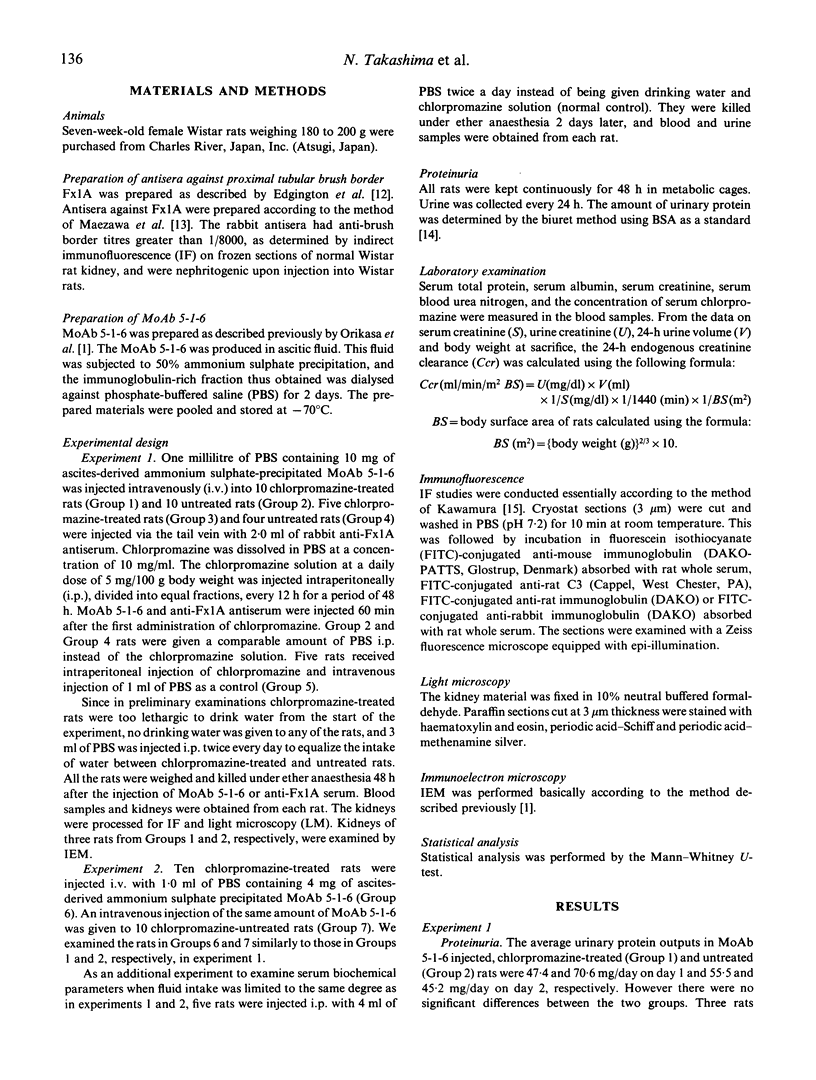Abstract
The effect of chlorpromazine, one of several calmodulin antagonists that inhibit cytoskeletal movement, on the local kinetics of injected proteinuria-inducing MoAb 5-1-6 was examined to test the hypothesis that proteinuria is inhibited if the antigen recognized by MoAb 5-1-6 or injected MoAb remains on the surface of epithelial foot processes. MoAb 5-1-6 was injected into both chlorpromazine-treated (5 mg/100 g body weight) and untreated rats. As a positive control for the chlorpromazine treatment, anti-Fx1A serum was also injected into other chlorpromazine-treated and untreated rats. Chlorpromazine inhibited neither the change in localization of injected MoAb 5-1-6 nor proteinuria, although it showed an inhibitory effect on redistribution of immune complex and the fixation of complement in passive Heymann glomerulonephritis induced by injection of anti-Fx1A serum. We conclude that the kinetics of bound MoAb 5-1-6 are regulated by a system different from that operating in passive Heymann glomerulonephritis.
Full text
PDF





Images in this article
Selected References
These references are in PubMed. This may not be the complete list of references from this article.
- Brown V. I., Greene M. I. Molecular and cellular mechanisms of receptor-mediated endocytosis. DNA Cell Biol. 1991 Jul-Aug;10(6):399–409. doi: 10.1089/dna.1991.10.399. [DOI] [PubMed] [Google Scholar]
- Camussi G., Brentjens J. R., Noble B., Kerjaschki D., Malavasi F., Roholt O. A., Farquhar M. G., Andres G. Antibody-induced redistribution of Heymann antigen on the surface of cultured glomerular visceral epithelial cells: possible role in the pathogenesis of Heymann glomerulonephritis. J Immunol. 1985 Oct;135(4):2409–2416. [PubMed] [Google Scholar]
- Camussi G., Noble B., Van Liew J., Brentjens J. R., Andres G. Pathogenesis of passive Heymann glomerulonephritis: chlorpromazine inhibits antibody-mediated redistribution of cell surface antigens and prevents development of the disease. J Immunol. 1986 Mar 15;136(6):2127–2135. [PubMed] [Google Scholar]
- Colin F. C., Schrier S. L. Spontaneous endocytosis in human neonatal and adult red blood cells: comparison to drug-induced endocytosis and to receptor-mediated endocytosis. Am J Hematol. 1991 May;37(1):34–40. doi: 10.1002/ajh.2830370108. [DOI] [PubMed] [Google Scholar]
- Edgington T. S., Glassock R. J., Dixon F. J. Autologous immune complex nephritis induced with renal tubular antigen. I. Identification and isolation of the pathogenetic antigen. J Exp Med. 1968 Mar 1;127(3):555–572. doi: 10.1084/jem.127.3.555. [DOI] [PMC free article] [PubMed] [Google Scholar]
- Kawachi H., Matsui K., Orikasa M., Morioka T., Oite T., Shimizu F. Quantitative studies of monoclonal antibody 5-1-6-induced proteinuric state in rats. Clin Exp Immunol. 1992 Feb;87(2):215–219. doi: 10.1111/j.1365-2249.1992.tb02977.x. [DOI] [PMC free article] [PubMed] [Google Scholar]
- Levin R. M., Weiss B. Selective binding of antipsychotics and other psychoactive agents to the calcium-dependent activator of cyclic nucleotide phosphodiesterase. J Pharmacol Exp Ther. 1979 Mar;208(3):454–459. [PubMed] [Google Scholar]
- Loor F., Forni L., Pernis B. The dynamic state of the lymphocyte membrane. Factors affecting the distribution and turnover of surface immunoglobulins. Eur J Immunol. 1972 Jun;2(3):203–212. doi: 10.1002/eji.1830020304. [DOI] [PubMed] [Google Scholar]
- Maezawa A., Ogiwara T., Matsui K., Suzuki Y., Nakamura T., Oite T., Shimizu F. Long-term observation of passive Heymann nephritis. Nephron. 1985;41(4):348–353. doi: 10.1159/000183613. [DOI] [PubMed] [Google Scholar]
- Matter K., Bucher K., Hauri H. P. Microtubule perturbation retards both the direct and the indirect apical pathway but does not affect sorting of plasma membrane proteins in intestinal epithelial cells (Caco-2). EMBO J. 1990 Oct;9(10):3163–3170. doi: 10.1002/j.1460-2075.1990.tb07514.x. [DOI] [PMC free article] [PubMed] [Google Scholar]
- Orikasa M., Matsui K., Oite T., Shimizu F. Massive proteinuria induced in rats by a single intravenous injection of a monoclonal antibody. J Immunol. 1988 Aug 1;141(3):807–814. [PubMed] [Google Scholar]
- Parton R. G., Simons K. Endocytosis in the kidney: insights from the MDCK cell system. Semin Nephrol. 1991 Jul;11(4):440–452. [PubMed] [Google Scholar]
- Rahwan R. G., Piascik M. F., Witiak D. T. The role of calcium antagonism in the therapeutic action of drugs. Can J Physiol Pharmacol. 1979 May;57(5):443–460. doi: 10.1139/y79-069. [DOI] [PubMed] [Google Scholar]
- Schreiner G. F., Unanue E. R. Membrane and cytoplasmic changes in B lymphocytes induced by ligand-surface immunoglobulin interaction. Adv Immunol. 1976;24:37–165. doi: 10.1016/s0065-2776(08)60329-6. [DOI] [PubMed] [Google Scholar]
- Schreiner G. F., Unanue E. R. The disruption of immunoglobulin caps by local anesthetics. Clin Immunol Immunopathol. 1976 Sep;6(2):264–269. doi: 10.1016/0090-1229(76)90118-5. [DOI] [PubMed] [Google Scholar]



